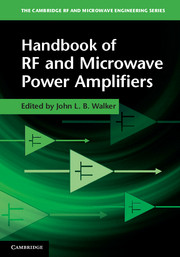Book contents
- Frontmatter
- Contents
- Contributors
- Preface
- 1 Silicon LDMOS and VDMOS transistors
- 2 GaAs FETs – physics, design, and models
- 3 Wide band gap transistors – SiC and GaN – physics, design and models
- 4 Amplifier classes, A to S
- 5 Computer-aided design of power amplifiers
- 6 Practical HF/VHF/UHF RF power amplifier realization
- 7 Microwave hybrid amplifier realization
- 8 Monolithic power amplifiers
- 9 RF power amplifier thermal design
- 10 Reliability
- 11 Power amplifier applications
- 12 Amplifier measurements
- About the authors
- Index
- References
3 - Wide band gap transistors – SiC and GaN – physics, design and models
Published online by Cambridge University Press: 05 November 2011
- Frontmatter
- Contents
- Contributors
- Preface
- 1 Silicon LDMOS and VDMOS transistors
- 2 GaAs FETs – physics, design, and models
- 3 Wide band gap transistors – SiC and GaN – physics, design and models
- 4 Amplifier classes, A to S
- 5 Computer-aided design of power amplifiers
- 6 Practical HF/VHF/UHF RF power amplifier realization
- 7 Microwave hybrid amplifier realization
- 8 Monolithic power amplifiers
- 9 RF power amplifier thermal design
- 10 Reliability
- 11 Power amplifier applications
- 12 Amplifier measurements
- About the authors
- Index
- References
Summary
Introduction
Although solid-state transistors have replaced vacuum electronics in the vast majority of microwave electronic systems over the past 40 years the revolution is not complete. In particular, the areas of high RF power for microwave and millimeter-wave radar and communications transmitter applications, the ability to produce adequate RF power levels at frequencies greater than 100 GHz, and the ability of devices to operate at high temperatures greater than about 250 °C remain dominated by microwave tubes. Further solid-state material and transistor developments in these areas are among the last frontiers for semiconductor electronics. In these areas solid state transistors have not been able to compete with vacuum tube devices, and most systems that must deliver kW to MW power levels are designed using various types of microwave tube.
The current state-of-the-art for microwave solid-state devices and for microwave tubes is shown in Figure 3.1. As indicated, solid-state devices produce RF power levels less than about 100 W and operate with reasonable RF output power to frequencies of about 100 GHz. The RF performance status shown in Figure 3.1 is for single device operation, and does not necessarily represent a true comparison of the RF output power capability of a system. Power combining and phased array technology permit the outputs of many solid state transistors to be combined, thereby producing significantly improved RF output power and solid state systems can, in practice, compete in terms of RF output power with tube-based systems in some cases. Combining technology can raise microwave RF output power into the kW range, at least through S band and into Ku band [1–4], and theoretically to much higher power levels. However, such multidevice concepts are increasingly difficult to apply as operating frequency increases and cannot extend the upper frequency limit beyond the present state-of-the-art. Operation at frequencies above X band and up to 100 GHz with RF output power in the hundreds of watts or kW range will require new semiconductor materials and/or transistor concepts.
- Type
- Chapter
- Information
- Handbook of RF and Microwave Power Amplifiers , pp. 103 - 158Publisher: Cambridge University PressPrint publication year: 2011
References
- 1
- Cited by

